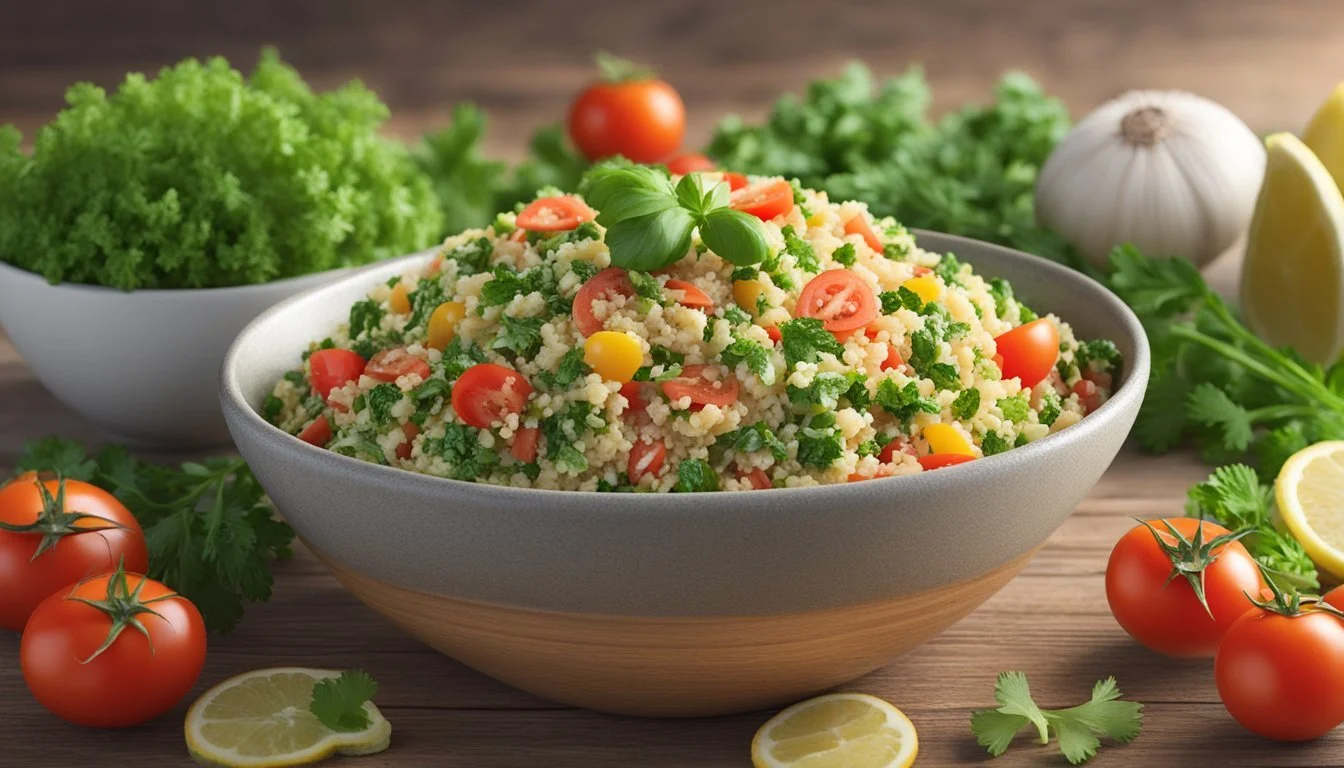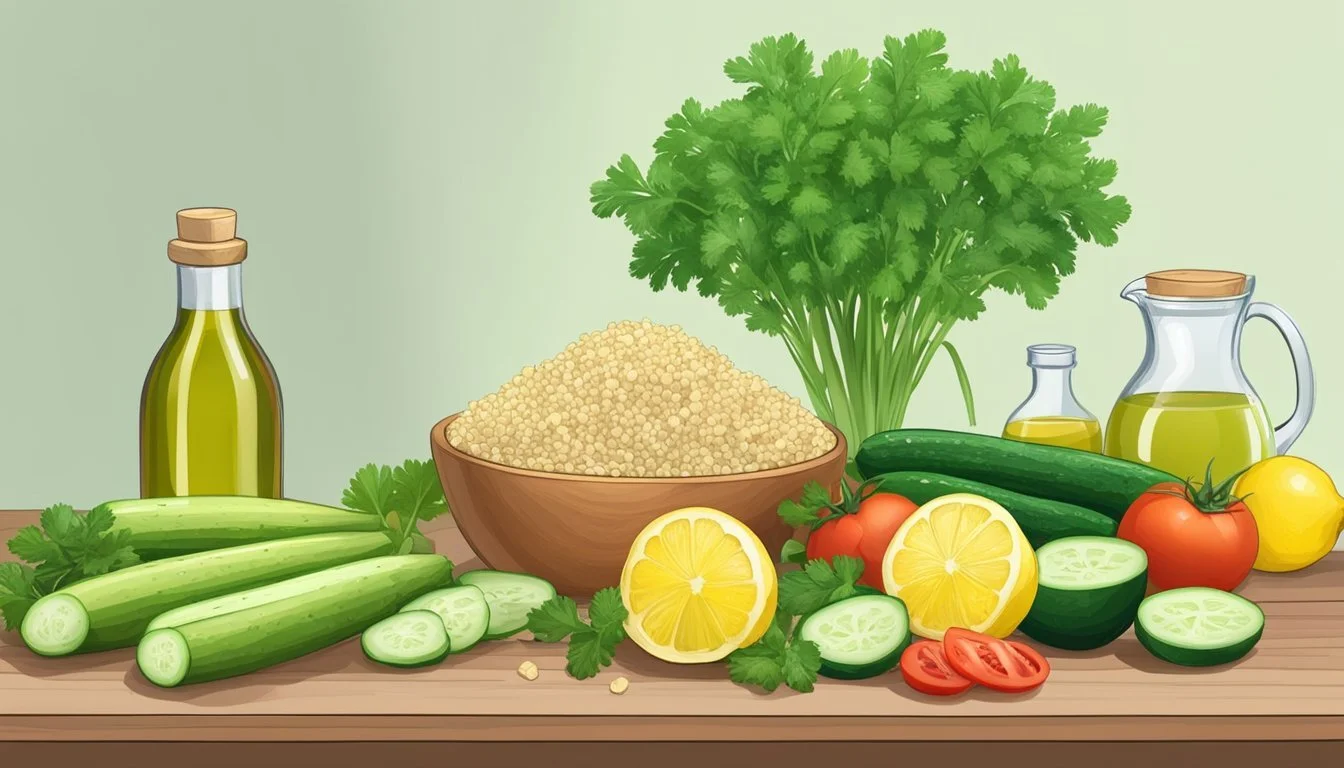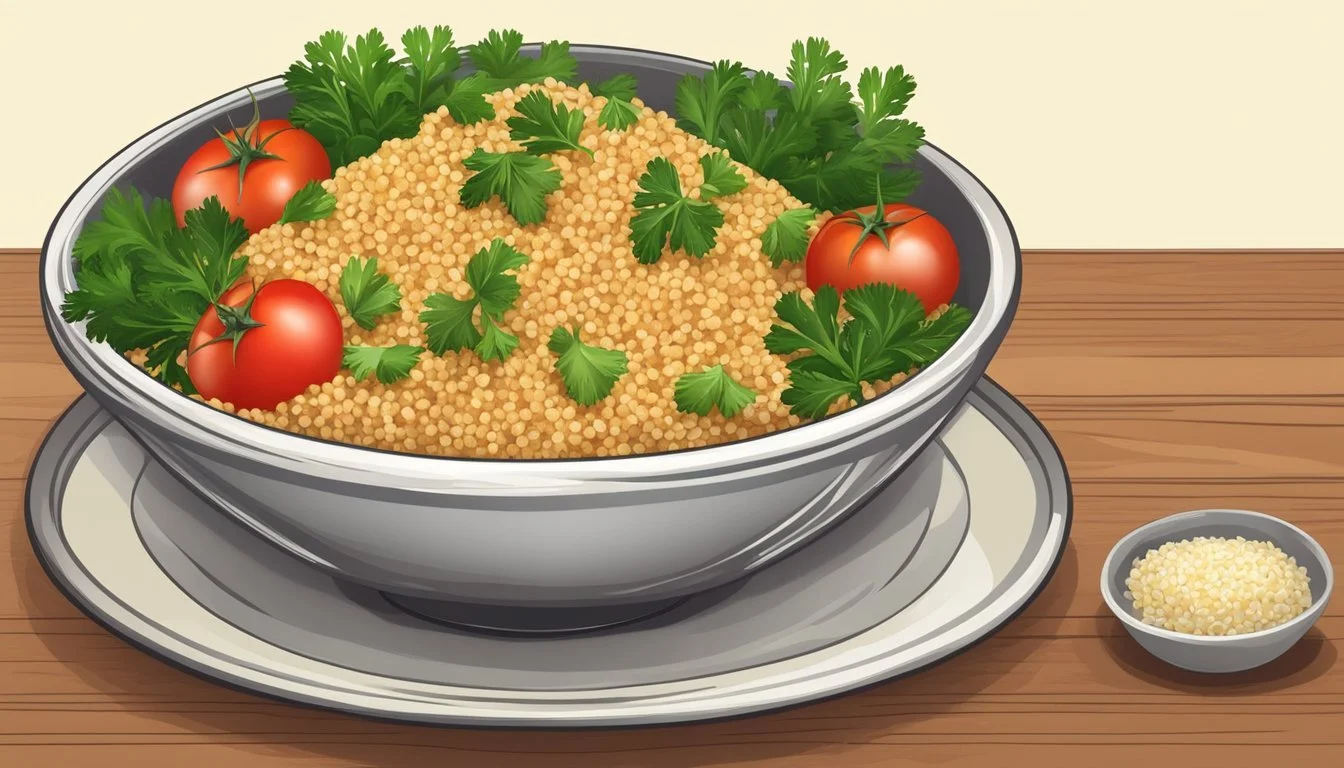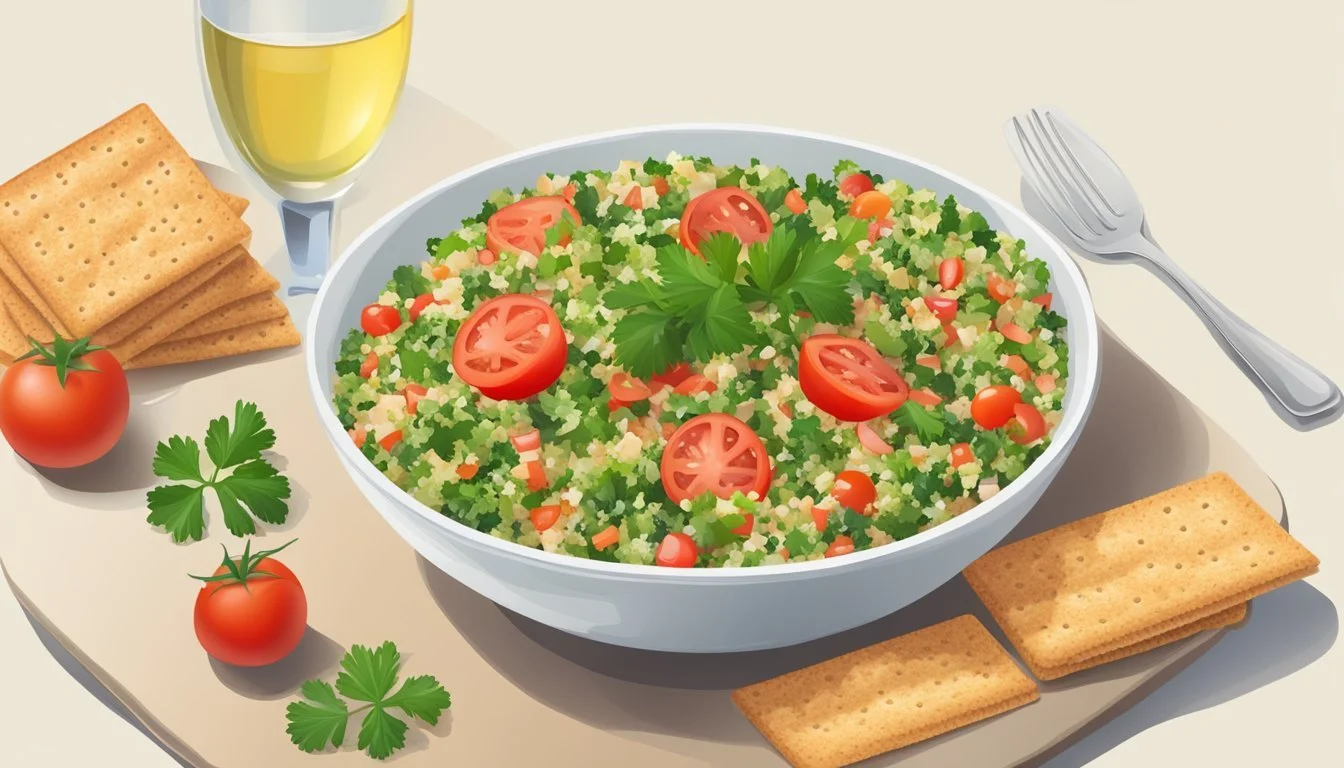Is Tabbouleh Gluten-Free?
Understanding the Classic Dish’s Ingredients
Tabbouleh is a traditional Middle Eastern salad known for its refreshing mix of herbs, vegetables, and grains. One key component of classic tabbouleh is bulgur wheat, which contains gluten. Gluten, a family of proteins found in grains like wheat, barley, and rye, can cause health issues for individuals with celiac disease or gluten sensitivities. As awareness and diagnoses of these conditions have increased, so has the demand for gluten-free options.
This demand has inspired variations of traditional recipes, and tabbouleh is no exception. Gluten-free versions of tabbouleh are not only possible but also widely enjoyed. These adaptations employ gluten-free grains like quinoa, (What wine goes well with quinoa?) buckwheat, or millet as alternatives to bulgur wheat. By making these simple substitutions, those with gluten intolerance or celiac disease can savor tabbouleh without the adverse effects of gluten.
The modified recipes maintain the essence of the dish—fresh vegetables, like tomatoes, cucumbers, and green onions, combined with a generous amount of parsley and dressed with lemon juice and olive oil. The result is a dish that remains true to the spirit of traditional tabbouleh while being safe and enjoyable for a wider audience, including those following a gluten-free diet.
Understanding Tabbouleh
Tabbouleh is a vibrant and healthful salad with a unique blend of flavors and textures. This section delves into the definition of tabbouleh, its origins, and how traditional recipes have evolved over time.
Defining Tabbouleh
Tabbouleh, sometimes spelled tabouli, is a Middle Eastern salad known for its fresh ingredients and bright, tangy flavor profile. The classic ingredients include bulgur wheat, fresh parsley, mint, tomatoes, onions, and a dressing made with lemon juice and olive oil. The hallmark of traditional tabbouleh is its emphasis on herbs, with bulgur playing a secondary role.
Origins and Cultural Significance
This dish has roots in the Levant, a historical region of the Middle Eastern Mediterranean. It is a cornerstone of Lebanese cuisine and has significant cultural importance in the region. Tabbouleh not only serves as a refreshing side dish but also represents a legacy of agrarian societies that celebrated the bounty of fresh produce in their cooking.
Traditional vs. Modern Variations
While traditional tabbouleh is made with bulgur, a form of whole wheat durum, and is not gluten-free, modern variations adapt to dietary needs by substituting the bulgur. Ingredients like quinoa, millet, or buckwheat serve as gluten-free alternatives, maintaining the salad's texture and nutritional profile. Advances in international cuisine have facilitated the global popularity of tabbouleh, leading to diverse adaptations that respect the essence of the dish while making it accessible to a wider audience.
Ingredients Breakdown
To determine if tabbouleh is gluten-free, one must examine each ingredient used in its preparation. Recognizing potential sources of gluten is crucial for those with gluten sensitivities or celiac disease to safely enjoy this dish.
Common Ingredients of Tabbouleh
Parsley: The herb that gives tabbouleh its signature fresh taste. Parsley is naturally gluten-free.
Tomatoes: Used to add a juicy, tangy flavor. Tomatoes are gluten-free.
Mint: An herb that provides a distinctive refreshing taste. Mint is gluten-free.
Cucumber: Adds crunch and hydration to the salad. Cucumbers are gluten-free.
Lemon Juice: Squeezed from fresh lemons, it brightens the dish's flavors and is gluten-free.
Olive Oil: Typically, extra virgin olive oil is used for its quality and flavor, also gluten-free.
Salt: Used to enhance all the flavors, salt is inherently gluten-free.
Potential Gluten-Containing Ingredients
Bulgur Wheat: A traditional grain used in tabbouleh which contains gluten. People with gluten intolerance or celiac disease should avoid bulgur.
Gluten-Free Alternatives for Ingredients
To make tabbouleh gluten-free, alternative grains can be used:
Quinoa: A popular gluten-free substitute that delivers a similar texture to bulgur.
Cook according to package instructions and substitute directly for bulgur.
Millet: Another gluten-free grain that can be used as a substitute.
Like rice, it has a 2:1 water to grain ratio when cooking: for a recipe calling for 1 cup bulgur, one would use ½ cup millet.
For a safe, gluten-free version of tabbouleh, one should ensure that all ingredients, especially grains replacing bulgur, are certified gluten-free and that there's no cross-contamination during preparation.
Preparing Tabbouleh
When preparing tabbouleh, one should follow accurate measurements and procedures to ensure a gluten-free result. Particular attention should be given to ingredient selection, especially the substitution of traditional bulgur with gluten-free grains.
Step-by-Step Instructions
Begin with the Grain: Start by boiling water in a medium saucepan. Add your choice of gluten-free grain like quinoa or buckwheat. For every cup of grain, use two cups of water. Let it simmer after bringing to a boil until the water is absorbed, which is approximately 15 minutes.
Chopping the Vegetables: While the grain cooks, finely chop fresh vegetables including parsley, mint, tomatoes, and green onions. For authenticity, a large amount of parsley should be used.
Making the Dressing: In a separate bowl, whisk together fresh lemon juice, olive oil, salt, and spices like allspice or a seven-spice blend to create the dressing.
Combining the Ingredients: In a large mixing bowl, combine the cooked and slightly cooled grain with the chopped vegetables.
Adding the Dressing: Pour the dressing over the grain and vegetable mix. Toss everything together to ensure the flavors meld. Chill before serving to allow the flavors to develop fully. As a tip, for best results, let the tabbouleh sit for a few hours in the refrigerator.
Equipment Needed
Cookware: A medium saucepan for cooking the grain.
Cutting Board: A stable cutting board for chopping vegetables.
Knife: A sharp knife is crucial for finely chopping herbs and vegetables.
Measuring Cups and Spoons: Accurate measuring equipment for the grain, water, and dressing components.
Mixing Bowls: A large bowl to combine the ingredients and smaller ones for preparing the dressing.
Whisk or Fork: For mixing the dressing.
Food Processor (optional): If available, a food processor can be used to finely chop the herbs quickly and efficiently.
Using the right equipment and following the precise gluten-free modifications to the classic tabbouleh recipe, one can easily prepare this healthy and flavorful Middle Eastern salad.
Adapting Tabbouleh for Gluten-Free Diets
Adapting traditional tabbouleh for gluten-free diets involves selecting suitable grains and ensuring that the preparation process is free from gluten cross-contamination.
Choosing the Right Gluten-Free Grain
For those following a gluten-free diet, the classic bulgur wheat in tabbouleh can be substituted with various gluten-free grains to maintain the texture and nutritional value of the dish. Quinoa is a popular choice due to its versatility, complete protein profile, and its ability to absorb flavors well. It must be thoroughly rinsed before cooking to remove its natural coating of saponins, which can impart a bitter taste. Cook the quinoa in boiling water for approximately 15 minutes until the grains become translucent and the germ has spiraled out.
Another excellent gluten-free option is millet, which contributes a mild, nutty flavor to the dish. When using millet for a tabbouleh recipe, it should be prepared with a light toasting before boiling, enhancing its flavor profile. Millet tabbouleh can offer a unique twist to the traditional version while maintaining a gluten-free standing.
Ensuring Cross-Contamination Avoidance
One of the critical aspects of preparing gluten-free tabbouleh is safeguarding against cross-contamination with gluten-containing ingredients. This involves:
Kitchen Tools: Using separate utensils, cutting boards, and bowls, dedicated solely to gluten-free cooking.
Preparation: Thoroughly cleaning all surfaces and tools that have previously come into contact with gluten.
Ingredient Selection: Choosing ingredients, such as spices and seasoning, that have been certified gluten-free to ensure they have not been contaminated during their processing.
By meticulously following these steps, chefs can confidently serve gluten-free tabbouleh or tabouli as a safe option for those with gluten sensitivities or celiac disease.
Serving and Pairing Suggestions
When considering tabbouleh, one should think of it as a versatile salad that can complement a variety of dishes, especially within Mediterranean and Middle Eastern cuisine.
What to Serve with Tabbouleh
Tabbouleh pairs exceptionally well as a side dish during lunch or dinner. One of the most common pairings is hummus, which can be offered alongside tabbouleh to create a balance of flavors. Additionally, incorporating falafel adds a hearty element, making the combination a filling meal in itself. To enhance the experience, include warm pita bread for scooping and enjoying the tabbouleh and hummus together.
Hummus: A creamy dip that complements the crispness of tabbouleh.
Falafel: Deep-fried chickpea patties that add a savory bite to the meal.
Pita Bread: Soft, pillowy bread perfect for wrapping or dipping.
Incorporating Tabbouleh into Meals
Tabbouleh can be utilized creatively in various meals. It's an excellent filling for a sandwich, offering a refreshing crunch. For a more substantial option, serve it with grilled halloumi, which provides a salty, chewy contrast to the salad. Additionally, incorporating tabbouleh into a mezze platter alongside tzatziki, a cucumber and yogurt sauce, invites a diverse play of flavors and textures, engaging the palate.
Sandwich: Fresh tabbouleh nestled in hearty bread for a nutritious lunch option.
Grilled Halloumi: A firm, grillable cheese that stands up to the bold flavors of tabbouleh.
Tzatziki: A cool and tangy sauce that provides a creamy counterpart.
Mezze: An assortment of small dishes, perfect for sampling a bit of everything.
Nutritional Information
Tabbouleh is a light and nutritious dish, teeming with health benefits due to its inclusion of fresh vegetables and herbs. The dish is particularly accommodating for those with specific dietary needs, being inherently vegan and gluten-free when made with gluten-free grains.
Health Benefits of Tabbouleh
Tabbouleh offers a variety of health benefits primarily because it is rich in fresh vegetables and herbs. It is a significant source of vitamins, especially vitamin A and vitamin C, both of which are known to boost the immune system and promote healthy skin. Furthermore, the dish is typically made with a base of parsley which is rich in iron and magnesium; these minerals are crucial for maintaining healthy blood cells and muscle function, respectively. The addition of tomatoes enhances both the flavor and the nutritional profile, adding lycopene, an antioxidant associated with heart health.
Dietary Considerations
For those observing a vegan or vegetarian diet, tabbouleh is an appealing option as it contains no animal products. It's also dairy-free and egg-free, making it suitable for anyone with dairy or egg allergies. When tabbouleh is prepared with gluten-free grains such as quinoa or millet, it becomes a safe choice for those with gluten intolerance or celiac disease. It's worth noting that gluten-free grains like quinoa also contribute a decent amount of protein to the meal, which is essential for the body’s repair and growth functions. Here's the key nutritional information framing tabbouleh's suitability for various diets and its health advantages:
Vegan/Vegetarian: Contains no animal products.
Gluten-Free: Safe when made with gluten-free grains such as quinoa or millet.
Dairy-Free and Egg-Free: Contains no dairy or eggs, ideal for those with allergies.
Protein Source: Quinoa offers a complete protein, containing all nine essential amino acids.
Vitamin-Rich: High in vitamin A and C from fresh herbs and vegetables.
Mineral Content: Good source of iron and magnesium, particularly in parsley-based recipes.
Recipe Variations and Tips
When preparing a tabbouleh recipe, one must consider the original ingredients and their potential gluten content, alongside dietary needs and preferences for substitutions that maintain the essence of this classic dish.
Alternative Ingredients and Substitutions
For those looking to enjoy tabbouleh without gluten, quinoa is a favored substitute for the traditional bulgur wheat. Quinoa is not only gluten-free but also packs additional protein and essential amino acids, making it a nutritious alternative. Riced cauliflower, another gluten-free option, adds a different texture while keeping the dish light and healthy.
Grains: Replace bulgur with gluten-free grains such as:
Quinoa (most popular)
Brown rice
Millet
Herbs: Fresh mint leaves are integral to tabbouleh. However, if unavailable:
Substitute with a smaller quantity of dried mint (due to its more concentrated flavor)
Use a blend of other fresh herbs like parsley or cilantro for variation
Vegetables:
Tomatoes are a staple, but feel free to add red onion for a sharper bite.
Cucumber can add refreshing crunch but is optional.
Top Tip: Always use fresh lemon juice over bottled for the best flavor, and if desired, zest the lemon for an extra citrus note.
Creative Ways to Serve Tabbouleh
This versatile salad can be served in various ways, transcending the role of a mere side dish:
As a filling for lettuce wraps or stuffed vegetables
Paired with grilled lamb chops or roasted fish for a complete meal
Offered alongside a mezze platter with hummus, baba ganoush, and falafel
Used as a vibrant, flavorful topping for flatbreads or bruschetta
By considering these variations and top tips, one can enjoy a delicious, customized tabbouleh recipe that accommodates gluten-free needs without sacrificing the fresh, bright flavors that characterize this beloved Mediterranean salad.
Storing and Preserving Tabbouleh
Proper storage extends the freshness of tabbouleh and maintains its flavors, making it an excellent dish for leftovers or potlucks when prepared in advance. Adhering to best practices for storage is crucial, especially since tabbouleh often contains fresh ingredients like roma tomatoes and herbs, which can spoil if not handled correctly.
Best Practices for Storage
When storing tabbouleh, one should transfer the salad to an airtight container and refrigerate it. This practice helps to keep the tabbouleh fresh for 3-5 days. Introducing dressing to the salad only when ready to serve is advisable, as the acidity can break down the ingredients over time and turn them soggy. Here is a quick guideline:
In the refrigerator: Store in an airtight container for 3-5 days.
Dressing: Add just before serving to preserve texture.
Making Tabbouleh Ahead of Time
Tabbouleh can be made ahead of time, which is particularly useful for events like potlucks. When preparing tabbouleh in advance, keep the couscous (What wine goes well with couscous?) or grain base separate from the fresh components. Combine them with the dressing shortly before serving to ensure that everything remains crisp and full of flavor. Follow these steps:
Prepare couscous: Cook the couscous or chosen grain according to directions, but allow it to cool before mixing with other ingredients.
Chop vegetables: Dice the roma tomatoes and other fresh components.
Combine when ready: Mix the couscous with vegetables and dressing right before serving for the best texture and taste.
Frequently Asked Questions
This section addresses common concerns about tabbouleh's gluten content and provides guidance for preparing gluten-free versions of this dish effectively.
Common Queries About Tabbouleh and Gluten
Is traditional tabbouleh gluten-free?
Traditional tabbouleh is not gluten-free as it typically contains bulgur, which is made from wheat.Can tabbouleh be made gluten-free?
Yes, one can make gluten-free tabbouleh by using gluten-free grains such as quinoa, buckwheat, or finely chopped walnuts as substitutes.
Troubleshooting Preparation Issues
How does one ensure the gluten-free grain is cooked properly for tabbouleh?
Whether one is cooking quinoa, buckwheat, or using chopped walnuts, they should follow the cooking instructions specific to the substitute to avoid over or under-cooking.What are some tips for making flavorful gluten-free tabbouleh?
It is important to finely chop the parsley, mint, and green onions for a consistent texture and to thoroughly season with lemon juice, salt, olive oil, and spices as desired.
Engaging with Readers
In the realm of culinary arts and dietary choices, reader participation significantly enhances the value of content related to gluten-free Tabbouleh. Active engagement establishes a community of shared interests and insightful exchanges.
Comments and Feedback
Readers are encouraged to share their experiences and insights regarding gluten-free Tabbouleh through the comments section. This platform allows for a diverse range of perspectives and tips to be exchanged, from personal modifications to allergy-friendly ingredient suggestions.
Successful experiences: They can post about positive outcomes with gluten-free Tabbouleh recipes.
Challenges faced: Feedback on any difficulties encountered can help others troubleshoot similar issues.
Ingredient swaps: Suggestions for alternative ingredients that maintain the dish's integrity are welcome.
Newsletter and Updates
For those keen on continuous learning and staying informed about gluten-free recipes like Tabbouleh, subscribing to a newsletter is beneficial. The newsletter provides:
Regular updates on new gluten-free recipes and tips.
Exclusive content that deepens the reader's understanding of gluten-free cooking.
To subscribe, readers typically need to provide an email address, after which they'll receive curated content straight to their inbox.
Conclusion
Traditional tabbouleh is not gluten-free, as it typically contains bulgur wheat, which is a gluten-containing grain. However, individuals seeking a gluten-free option can still enjoy this dish by substituting bulgur with gluten-free grains such as quinoa, buckwheat, or millet. These grains mimic the texture of bulgur and are a safe alternative for those with celiac disease or gluten sensitivity.
Health benefits: The substitution grains are not only gluten-free but also contribute various health benefits. Quinoa offers a complete source of protein, buckwheat is rich in antioxidants, and millet is a good source of fiber. Furthermore, these grains, alongside the vital ingredients of parsley, mint, and fresh vegetables, contribute to a nutritionally rich meal.
Preparation tips: When preparing gluten-free tabbouleh, it is essential to:
Cook the chosen gluten-free grain as directed—usually with a 2:1 ratio of water to grain.
Allow the cooked grain to cool before incorporating it into the salad.
Ensure all ingredients, such as spices and oils, are free from gluten cross-contamination.
Prioritizing non-contaminated ingredients confirms the dish remains gluten-free, making it suitable for a wider audience, including those who prioritize a gluten-free diet, whether for health or lifestyle reasons.









